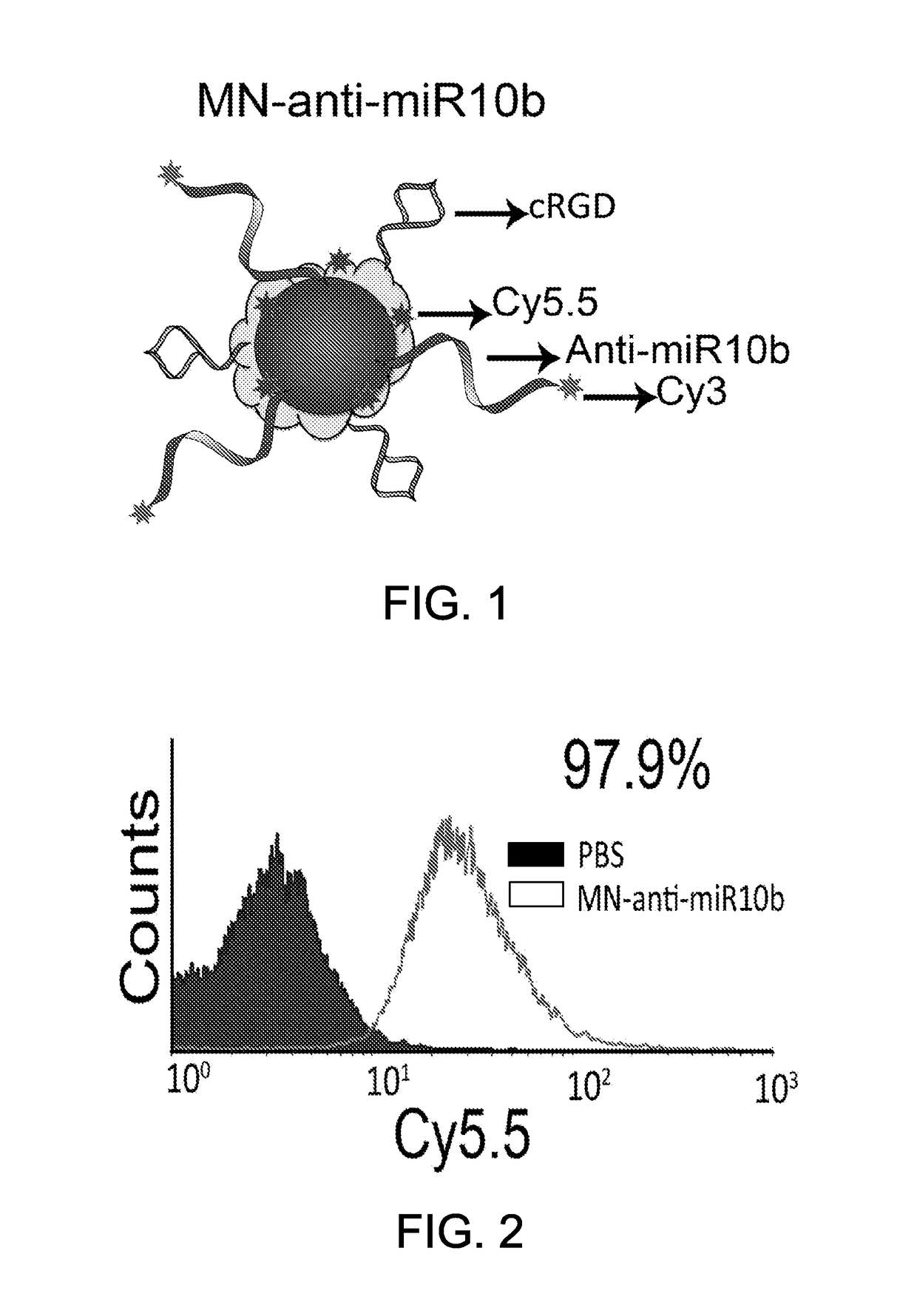Therapeutic nanoparticles and methods of use thereof
a technology of nanoparticles and nanoparticles, applied in the field of therapeutic nanoparticles, can solve the problems of breast cancer reappearing, metastasis can occur, morbidity and mortality associated with this disease remain alarming, etc., and achieve the effect of decreasing cancer cell invasion or metastasis
- Summary
- Abstract
- Description
- Claims
- Application Information
AI Technical Summary
Benefits of technology
Problems solved by technology
Method used
Image
Examples
example 1
d Activity of Therapeutic Nanoparticles in Breast Tumor Cells
[0141]Twenty to thirty-five nm dextran-coated therapeutic magnetic nanoparticles were conjugated to the tumor-targeting peptide, cRGD. These therapeutic magnetic nanoparticles were further functionalized with knock-down locked nucleic acid (LNA) oligonucleotides (1.5 nmoles LNA / mL) targeting human miRNA-10b and the fluorophore, Cy5.5. The resulting therapeutic magnetic nanoparticles are hereafter referred to as “MN-RGD-anti-miR-10b” (see, FIG. 1). These therapeutic magnetic nanoparticles were generated as described below.
[0142]Synthesis of Therapeutic Magnetic Nanoparticles
[0143]Therapeutic magnetic nanoparticle (MN) synthesis was modified from a protocol published previously (Medarova et al., Nat. Protocols 1:429-435, 2006). Briefly, 9 g of Dextan-T10 (Pharmacosmos, Denmark) was dissolved in 30 mL of double-distilled water and stirred in a round bottom flask on ice. Iron (III) chloride hexahydrate (FeCl3.6H2O) (0.65 g) wa...
example 2
ic Nanoparticles Decrease Breast Tumor Cell Invasion and Migration
[0164]Additional experiments were performed to determine whether treatment of breast tumor cells with MN-RGD-anti-miR-10b would result in a decrease in tumor cell invasion and / or migration. In these experiments, MDA-MB-231(gfp) cells were treated with MN-RGD-anti-miR-10b or a control magnetic nanoparticle containing a scrambled oligonucleotide (MN-scr-miR) for 48 hours and then analyzed using standard cell invasion and migration kits (Cell Biolabs, Inc., San Diego, Calif.). These experiments were performed according to the supplier's instructions. Briefly, MDA-MB-231 (0.1×106) cells were plated in each insert containing membrane (pore size 8 μm) and corresponding nanodrug (60 μg, 5.0 nmol LNA) was added with / without 10% FCS (fetal calf serum), and incubated for 24 hours for the migration assay and 48 hours for the invasion assay. The inserts were stained with the supplier's kit and membranes are imaged by light micros...
example 3
ic Nanoparticle Delivery to a Mouse Breast Cancer Model
[0166]Additional experiments were performed in nude mice implanted orthotopically with the MDA-MB-231(luc) cell line to determine whether the therapeutic nanoparticles described herein would show significant lymphotropism when injected intravenously into tumor-bearing mice, and to determine whether the therapeutic nanoparticles described herein can be used to treat primary and metastatic tumors in vivo. In vivo magnetic resonance imagine (MRI) was used to obtain information about the time course of magnetic particle delivery to tumor cells (Kumar et al., Cancer Res. 7553-7561, 2010; Medarova et al., Cancer Res. 69:1182-1189, 2009). These experiments were performed using the methods described below.
[0167]Animal Models
[0168]Six-week old female nude mice (nu / nu or NIH III nude) were implanted orthotopically with the human breast adenocarcinoma MDA-MB-231-luc-D3H2LN cell line (Caliper Life Sciences, Hopkinton, Mass.). In this model,...
PUM
| Property | Measurement | Unit |
|---|---|---|
| diameter | aaaaa | aaaaa |
| diameter | aaaaa | aaaaa |
| diameter | aaaaa | aaaaa |
Abstract
Description
Claims
Application Information
 Login to View More
Login to View More - R&D
- Intellectual Property
- Life Sciences
- Materials
- Tech Scout
- Unparalleled Data Quality
- Higher Quality Content
- 60% Fewer Hallucinations
Browse by: Latest US Patents, China's latest patents, Technical Efficacy Thesaurus, Application Domain, Technology Topic, Popular Technical Reports.
© 2025 PatSnap. All rights reserved.Legal|Privacy policy|Modern Slavery Act Transparency Statement|Sitemap|About US| Contact US: help@patsnap.com



